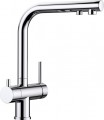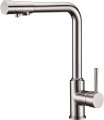Rotation angle
An angle to turn the drain. It is worth considering that in our case the angle is not considered relative to the center position, but the overall angle is right-left. In this way, the 110 degree value allows to rotate the mixer slurry with respect to the center position by 55° to the right and left.
Jet depth
Distance from the fixing point (for vertically mounted taps) or from the centre of the mounting hole (for horizontally mounted taps) to the middle of the spout. It is a characteristic that determines the "reach zone" of the tap.
Jet height
The jet height is usually specified for taps with horizontal installation (see "Type of installation"). It is measured from the base of the tap to the spout outlet. The large height of the spout is important primarily for kitchen models (see "Suitable for"), because it allows you to place large dishes in the sink. This parameter is directly related to the height of the spout (see above): the height of the jet cannot be greater than the height of the spout. Thus, in fact, one has to find a compromise between the height of the jet and the dimensions of the tap, especially if there is little space for its installation.
Inlet communication
The type of water pipes the tap is designed for.
— Hoses. With a flexible connection type, polymer tubes (hoses) are used to connect the tap to the water supply, which can bend well and are reinforced with a metal mesh for strength. This ensures ease and versatility of attachment — thanks to the flexibility of the pipe, it can be carried even in cramped places. On the other hand, such a supply is less durable and reliable than a rigid one. It is mainly used in models for kitchens and sinks (see "Suitable for"). Installation pipes may be included in the package of the tap; this point should be clarified separately.
— Rigid pipes. Such taps are designed for installing directly to metal water pipes. The advantage of this type is reliability and strength, the disadvantage is significant restrictions on the installation site: you either have to put the tap where the pipes were made during construction, or redo the communications, which is associated with great inconvenience and cost. On the other hand, such taps are usually used for bathtubs and showers, and in modern bathrooms, typically there are no problems with unsuccessful installation of pipes.
Finish
Type of additional finishing provided in the tap. This item can specify several options — this means that this model is available in different design options. And if the finishing material coincides with the body material, this means that there is virtually no additional coating; this is found, in particular, among taps made of stainless steel, which itself is quite resistant to corrosion.
In modern taps, the following types of finishing are used:
granite,
chrome,
chrome with granite,
chrome with gold,
matte chrome, stainless steel (
glossy or
brushed),
brass,
nickel,
copper,
bronze,
gold, as well as
brushed in one color or another. Here are the features of each option:
— Granite. Granite is characterized by a pleasant appearance, moreover, it is available in an abundance of different colours, allowing you to choose a tap for the design of the kitchen. Of its advantages, it is worth noting high durability, absolute resistance to corrosion and good sanitary characteristics (prevents the growth of bacteria). The main disadvantage is the high
...price.
— Chrome. Chrome plating is applied to metal surfaces primarily for corrosion protection; it has a characteristic shiny (almost mirror-like) appearance. Chrome provides high resistance to oxidation and damage, yet looks good and is inexpensive — as a result, it is one of the most widely used coating materials. Its main disadvantage is the tendency to get imprints on it over time; their removal is associated with certain troubles.
— Chrome/granite. The combination of chrome and granite finish in one product. See above for more details about the features of each of these materials, but here we note that their combination implies the presence of different types of finish in different parts of the tap. Thus, the design acquires a more original and stylish appearance, greater hygiene and resistance to contamination than pure chrome, while being cheaper than pure granite. And from the point of view of the overall design of a bathroom or kitchen, it is this combination that in some cases turns out to be the best option.
— Chrome/gold. The combination of chrome finish with individual "gold" sections. The features of chrome are described above, and the "gold" elements give the product a rich appearance, while a fairly large number of buyers prefer this combination to the “solid gold” finish.
— Matte chrome. A matte variation of chrome finish (see above). On such a surface, dirt, and prints are much less noticeable than on a classic glossy; in addition, it may be more suitable in design or simply more pleasing to the eye than glossy. At the same time, the creation of matte surfaces is associated with certain difficulties, and therefore they are relatively uncommon.
— Stainless steel (glossy). Stainless steel finish is generally similar in characteristics to chrome — it is durable and resistant to corrosion. However, such a surface is somewhat different in appearance and for a number of reasons it is used mainly in premium-class models — including taps made entirely of "stainless steel" (such models, in fact, have no finish).
— Stainless steel (brushed). Similar to matte chrome, such steel is more resistant to dirt than glossy (see above), otherwise it is completely identical to it.
— Brass. Brass coating is most often combined with a body made of the same material (that is, there is actually no special finish in such a tap). One of the advantages of such a surface is a pleasant golden hue, which is especially suitable for retro-style taps. At the same time, the cost of such products for a number of reasons turns out to be quite high, besides, they are prone to the appearance of hard-to-remove prints. Therefore, they are quite rare.
— Nickel. In terms of characteristics, nickel finish is similar to chrome and is used for the same purposes, however, for a number of reasons, it is much less common than chrome.
— Copper. Finish of characteristic reddish color. Copper can give an “old” look even to a modern product, and for retro-style taps, it can be simply irreplaceable. On the other hand, this material is expensive, in part because it is difficult for copper to provide sufficient corrosion resistance.
— Bronze. Bronze is an alloy based on the copper described above and is used similarly — mainly to provide an authentic look to retro-style taps. The main difference between the two materials is the color — the bronze is somewhat darker, and the red colour is not as pronounced in it (although specific shades in different models can also be different). In addition, this material is easier to make resistant to corrosion, so bronze products are much more common than copper ones.
— Gold. Yellow alloy finish to imitate the look of gold. It is used to give the tap a rich appearance, while at the same time it is expensive in itself, as a result of which it is used mainly in premium models — in order to emphasize the level of the product even brighter. On the practical side, like any material of this level, it is characterized by high resistance to oxidation, but resistance to pollution and ease of cleaning can be different (although in most cases these indicators are also on top).
— Brushed. A brushed finish that is applied specifically to give the product a certain color — most often black or white, but other options are also found. Accordingly, the main advantage of this option is a non-standard appearance: with paint, you can achieve colors that are not available with other types of finish. At the same time, any paint perfectly resists corrosion, and the differences between different models of taps with such a finish are mainly in durability and scratch resistance. These characteristics, usually, directly depend on the price category of the product.Tap height
The height of the tap, measured from its base or lowest point to the highest point of the spout. The height of the spout partly determines the installation possibilities — in fact, this is the minimum vertical free space that is required for the tap. In addition, in models with horizontal installation (see "Type of installation"), the spout height is related to the jet height (see below).

